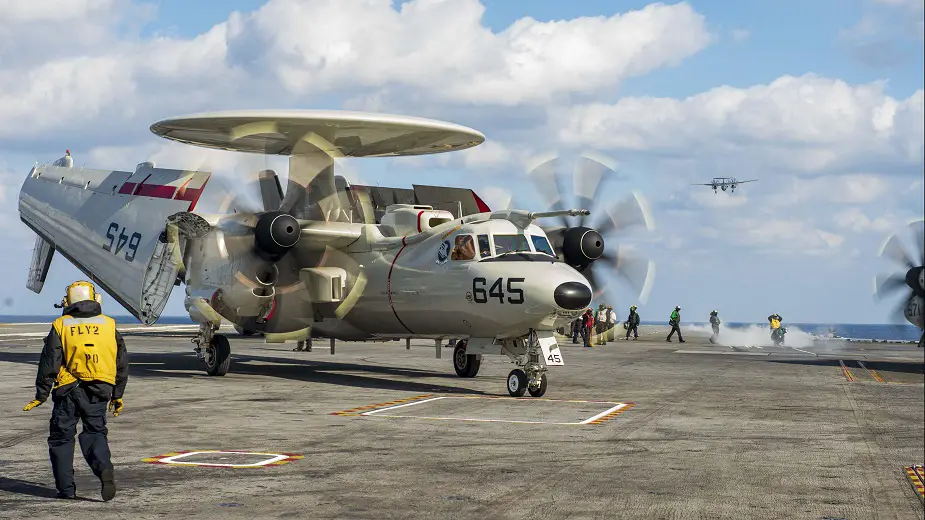The E-2D community reached its mission capable goal five months ahead of schedule recently thanks to efforts made by the E-2/C-2 Airborne Command & Control Systems Program Office (PMA-231) and the Airborne Command & Control Logistics Wing (ACCLOGWING).
Follow Air Recognition on Google News at this link

An E-2D Hawkeye, assigned to the "Greyhawks" of Carrier Airborne Command and Control Squadron (VAW) 120, taxis on the flight deck of the Nimitz-class aircraft carrier USS Dwight D. Eisenhower (CVN 69) while operating in the Atlantic Ocean. The E-2D community reached its mission capable goal ahead of schedule with all-hands-on-deck focused on sustaining and surpassing that goal, while reaching its fully mission capable goal (Picture source: US Navy)
“The F/A-18 and EA-18G have been a major focus of the Navy to significantly increase mission capability in the last several years. Now it’s time for the E-2D to step into the spotlight and take lessons learned from these other successful programs and the [Naval Sustainment System-Aviation], and integrate them into our own mission capable aircraft campaign,” said Capt. Pete Arrobio, PMA-231 program manager.
PMA-231 and ACCLOGWING launched the Naval Sustainment System-Aviation (NSS-A) efforts in 2020 to improve E-2D aircraft readiness with a goal to sustain 28 Mission Capable (MC) and 22 Fully Mission Capable (FMC) aircraft. The first objective of 28 MC E-2D was met for the first time on Feb. 3, five months ahead the planned target completion of July 1.
“This is an all-hands-on-deck effort across our community to reach, sustain and surpass 28 MC while, at the same time, getting after FMC,” said Arrobio.
The mission capable effort is structured around the six pillars of the NSS-A. The NSS-A applies an integrated approach to a data-informed and analytic-driven framework leveraging best practices from industry to increase spare parts, enhance capability and maintain aircraft to support the warfighter.
The roll-out involves the Organizational-level (O-level) Reform efforts of the NSS-A, an initiative that began approximately two years ago as a way to improve readiness across Naval Aviation. At the direction of the then-Secretary of Defense, the F/A-18 and EA-18G served as the initial communities to introduce NSS-A.
The pillars involved in the reform include the Maintenance Operation Center (MOC) Aircraft on Ground (AOG), Fleet Readiness Center (FRC) reform, O-level reform, Supply Chain reform, Engineering and Maintenance reform, and establishing a single point of accountability for governance and accountability.
Over the last month, 28 MC E-2Ds were available on average, which represents a significant accomplishment, said Arrobio, adding that they are moving towards sustaining and having sufficient amounts of spares on shelf to meet the Fleet’s need.
To sustain 28 aircraft, the program office is focused on ensuring there are 37 available E-2D aircraft out of the total inventory of 46. This number excludes aircraft in Planned Maintenance Interval (PMI) I, PMI II, Aerial Refueling (AR) modifications and additional planned modifications for the E-2D aircraft.
Concurrently, while focusing on MC, the program office and ACCLOGWING are aggressively moving towards achieving the need for 22 FMC E-2Ds.
“The Navy invested in the E-2D because of the unique and critical warfighting capabilities it brings to the Navy and the Joint Force,” said Capt. Mike France, Airborne Command & Control and Logistics Wing commander. “Persistently maintaining 28 MC is an important milestone, but achieving 22 FMC E-2Ds sets the stage for us to win against adversaries. This is the critical number that supports deployed squadrons and high-end training.”
Arrobio and France said the program office and ACCLOGWING have already made significant progress towards this objective by consolidating parts across prioritized aircraft, working with Naval Supply Systems Command Weapon Systems Support (NAVSUP WSS) and industry to accelerate spares and repairs, reliability improvements, and other initiatives to systemically attack FMC readiness degraders.
PMA-231’s mission is to develop, acquire and sustain unmatched carrier-based airborne command, control, and logistics aircraft with the E-2C Hawkeye, E-2D Advanced Hawkeye and C-2A Greyhound.
















